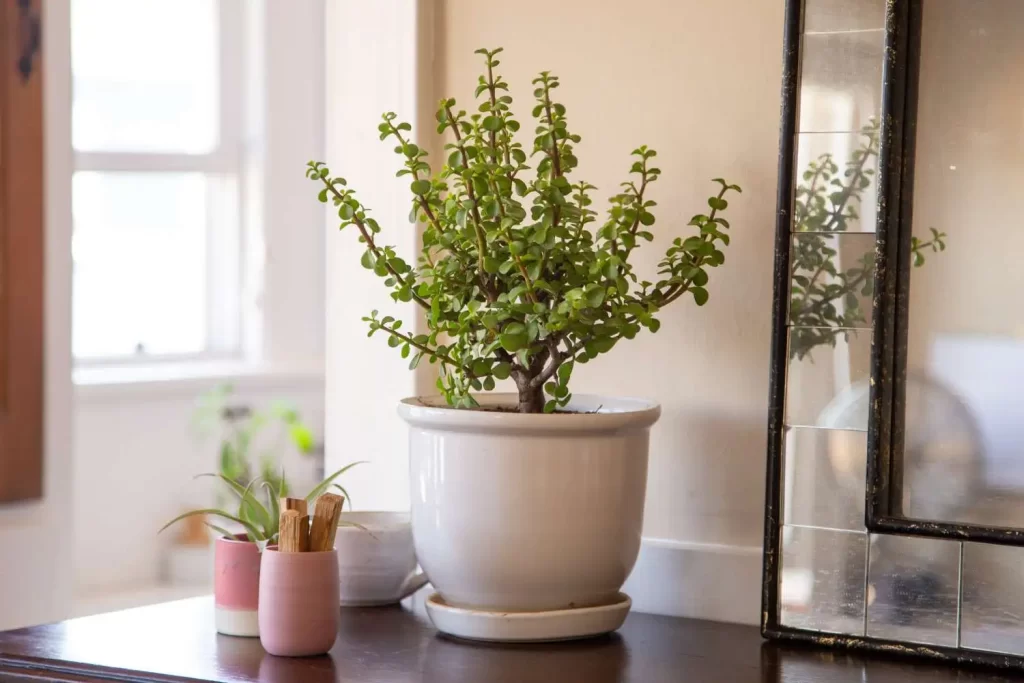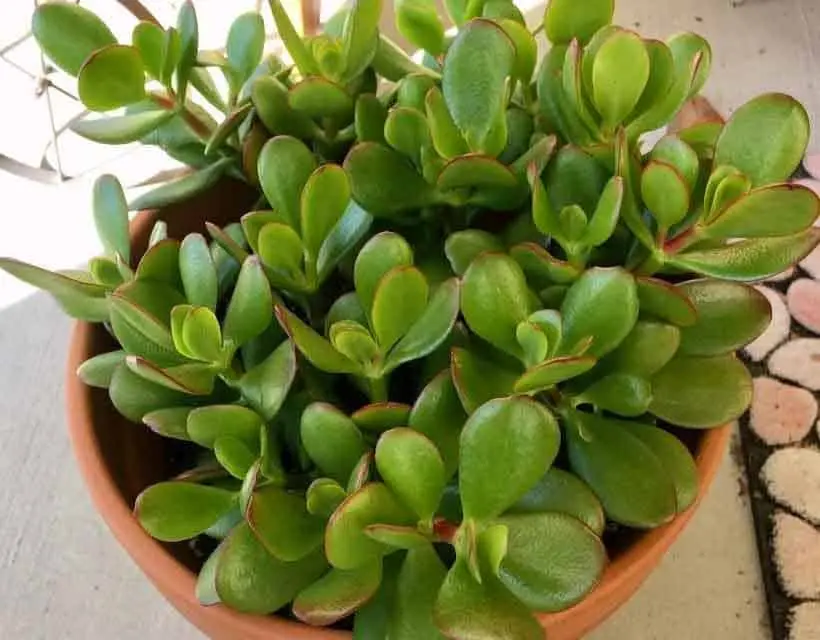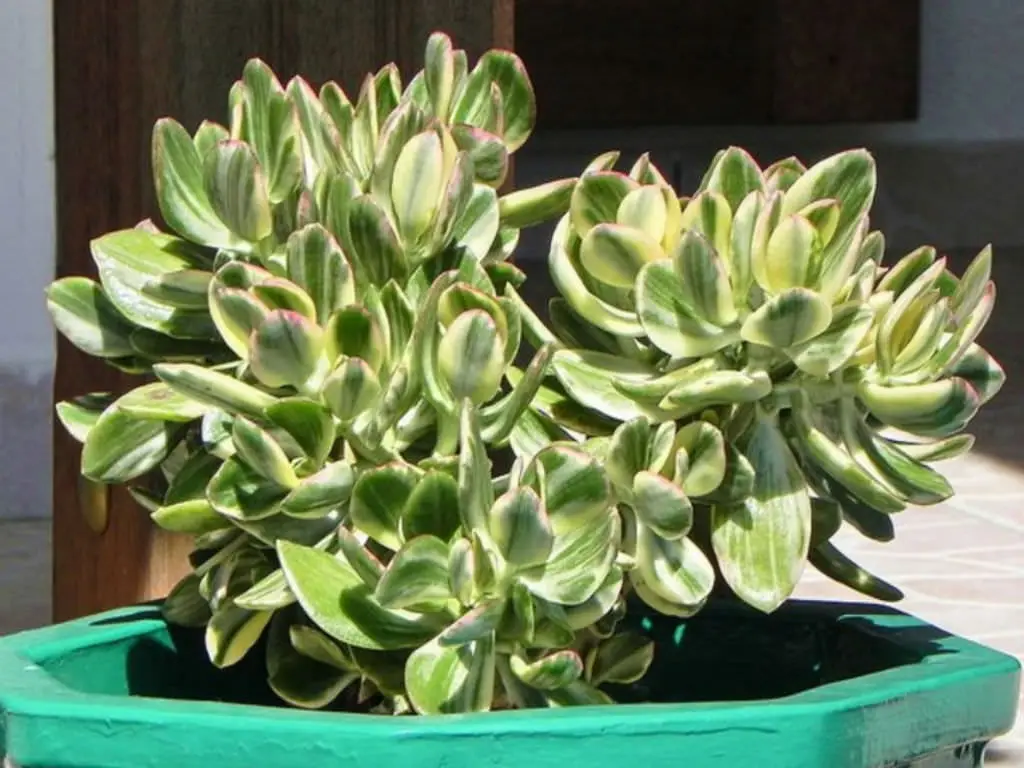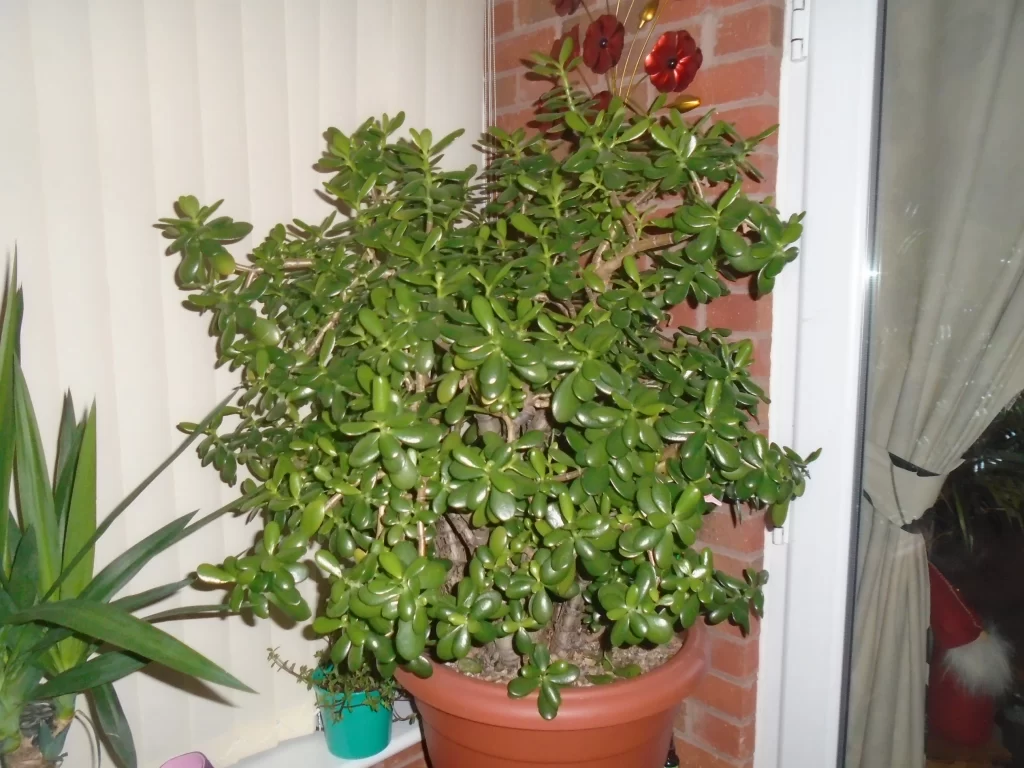There are many Jade plant types with different characteristics and growing habitats. Jade plants, also known as Crassula ovata, are a popular choice for indoor plants due to their low maintenance requirements and unique appearance.

The Enduring Beauty of Jade Plants
Before discussing jade plant types, let’s discuss the wonderful qualities of it. They are first and foremost low maintenance. In addition to their beauty, jade plants have numerous practical use. Many people keep these plants around all the time because of how nice they look and the positive vibes they give out.
Jade Plants overview
| Genus name | Crassula |
| Common name | Jade Plant |
| Plant type | Houseplant |
| Height | 3 to 10 feet |
| Width | 2 to 3 feet |
| Flower color | Pink or White |
| Foliage color | Blue/Green |
| Season features | Spring Bloom, Winter Bloom |
| Propagation | Stem Cuttings |
| Special features | Good for Containers, Low Maintenance |
Read: Silver Pothos – Types, Propagation, Care, and Problems
Exploring different types of jade plant
Common Jade Plant: Crassula Ovata

The jade plant, Crassula ovata, is a low-key yet attractive garden accent. This succulent’s broad, jade-green leaves and constant growth make it essential to any garden, inside or out. The beautiful appearance of this uncommon jade plant conceals a world of mystery. Crassula ovata thrives on South African rocky terrain. This hardy plant is welcome in our homes, offices, and gardens despite its tropical roots.
Crassula ovata’s woody, ever-expanding stems make it simple to recognize as a tree. Its shiny, oblong leaves give it a tree-like appearance. The light renders these leaves, the plant’s true stars, deep, vivid green with a tinge of crimson around the edges. The typical jade plant’s lifespan sells. Crassula ovata may live for decades and grow into a beautiful specimen. Jade plants may grow to 6 feet with ample light, making them attractive focus points.
Jade plants bloom in winter when other plants are dormant. This evergreen succulent blooms with pink or white star-shaped flowers. This fall blossoming spectacle, which reminds us that even common plants may have unusual traits, demands plenty of light and higher temperatures. With a little love and care, any jade plant may become a masterpiece.
Crassula Ovata ‘Hummel’s Sunset’: Golden Jade Plant

Crassula ovata Hummel’s Sunset, or Golden Jade Plant, is a unique jade plant. This jade plant brings a tropical sunset to your home or yard with its bright colors and durability.
South African native ‘Hummel’s Sunset’ is as hardy as its jade plant cousin. Its stunning sunset-like hues make it stand out. The succulent’s brilliant jade green, rich yellow, and fiery orange leaves make it seem almost showy. The golden and orange tones of the ‘Hummel’s Sunset’ grow more intense in bright light, giving this plant a magnificent sight. This succulent’s striking tint enhances the jade plant’s plump, oval leaves.
The ‘Hummel’s Sunset’ jade plant may grow to 6 feet tall in optimum circumstances. Its brilliant foliage gives it a lofty tree look. Imagine an indoor golden sunset tree. Winter rewards Golden Jade Plant growers. Winter clusters of white or pink star-shaped blossoms may sweeten this furious shrub.
The Golden Jade Plant symbolizes luck and prosperity. This justifies having this plant at home or work. It provides tropical flair and figurative meaning to your house. The ‘Hummel’s Sunset’ is ideal for gardeners of all skill levels since it requires the same maintenance as a standard jade plant. If you want a tropical-looking succulent with minimum upkeep, Crassula ovata ‘Hummel’s Sunset’ is perfect. This vivid jade will draw attention and bring color to any space or yard.
Crassula Ovata ‘Variegata’: Variegated Jade Plant

In the magical world of jade plants, Crassula ovata ‘Variegata’ the Variegated Jade Plant, is stunning. This plant’s diverse color palette and imaginative presentation attract plant enthusiasts who wish to spice up their yards.
The Variegated Jade Plant’s multicolored leaves distinguish it from other South African jade species. Each leaf has white, green, and yellow accents. This mosaic of brilliant colors gives the plant an exotic appeal and contrasts well with your solid-hued succulents.
Jade plants, like Crassula ovata ‘Variegata,’ have large, oval leaves and robust, woody stems. The variegated leaves are the true show-stoppers up close. Each has its distinct design and green tone. This vibrant palette may bloom in perfect lighting, turning the plant into a piece of beauty.
The Variegated Jade Plant is smaller than the traditional Jade plant but may grow to three feet inside. It’s a little burst of nature in your house with robust, tree-like dimensions.
The Variegated Jade Plant, like other jades, blooms in winter. Its variegated leaves and star-shaped pink blossoms contrast well. This blend adds natural beauty to any scene with its vibrant colors and forms.
Crassula ovata ‘Variegata”s jade plant variation is amazing. Its distinctive color, compact size and little upkeep make it noteworthy. The Variegated Jade Plant will brighten your day and bring you luck, whether you are a succulent expert or a beginner.
Read: Marble Queen Pothos – Propagation, Care, Uses, and Problems
Crassula arborescens

The Silver Jade Plant, or Crassula arborescens, is a rare and attractive jade plant. Any succulent collection would benefit from its silvery tint and rounded leaves. South African highlands are home to the interesting Silver Jade Plant. Crassula arborescens contrasts with its jade-green cousins. Their flat, spherical form and blue-gray tint give the plant a silvery shine. The modest scarlet leaf edges enhance the plant’s appeal.
Due to its robust, tree-like structure and strong, woody stalks that contain its silver-blue leaves, the Silver Jade Plant resembles a little tree. This building’s 3–6-foot height makes it a showstopper inside. Imagine a little silver-blue tree in your home or workplace with dazzling leaves reflecting natural or soft artificial light.
The Silver Jade Plant is beautiful and gives its donors a wonderful winter surprise. It blooms with small, star-shaped scarlet blossoms that contrast with the evergreen succulent’s silvery blue leaves under ideal circumstances. Silver Jade Plants are elegant succulents that are hardy. It is ideal for both experienced gardeners and beginners due to its versatility and inexpensive upkeep.
Due to its distinctive color and style, the Silver Jade Plant stands out among jade plants. Its rapid growth, silvery beauty, and easy care make it a desirable plant. If you want a sturdy, colorful plant, the Silver Jade Plant (Crassula arborescens) is ideal.
Crassula Ovata ‘Gollum’: Gollum Jade
Crassula ovata ‘Gollum,’ or Gollum Jade, is one of the most intriguing succulents. Its odd leaf form and alien-like look fascinate gardeners of all skill levels. Gollum Jade is a South African jade plant with a unique look. The plant’s trumpet-shaped leaves and brilliant scarlet apex make it stand out. This jade plant’s leaves resemble the character’s fingers, making it readily recognized.
In a regulated setting, the Gollum Jade may grow to three feet. Its sturdy, treelike structure and vivid green, finger-like leaves create a striking centerpiece inside or out. In colder months, the Gollum Jade may bloom with star-shaped, white, or pink blossoms that contrast well with its green “fingers.” Gollum Jade, like other jade plants, brings luck and prosperity. It’s a lovely, lucky addition to your plant collection.
The Gollum Jade is a beautiful, low-maintenance plant. It celebrates jade plant diversity and reminds us that gardening can be magical.
Crassula Ovata ‘Minima’: Dwarf Jade
Size doesn’t matter when using nature in home design. Dwarf Jade, Crassula ovata ‘Minima,’ is a wonderful specimen. This little jade plant has a captivating beauty. South Africa produced dwarf jades, too. Houseplant owners adore the jade plant’s jade-green leaves. Dwarf Jades have smaller, rounder, and plumper leaves, making them adorable.
The Dwarf Jade’s little, star-shaped, white or pink blossoms develop in the colder months, delighting carers. Dwarf Jades are simple to maintain. It’s perfect for those who want a pretty plant but don’t want to care for it.
Crassula ovata ‘Minima’ shows that little plants may be beautiful and resilient. This little powerhouse brings the plant world to any garden, inside or out. The Dwarf Jade introduces new and experienced plant parents to the intriguing world of jade plants.
Crassula Ovata ‘Crosby’s Compact’
Even little plants may be spectacular. The Crassula ovata ‘Crosby’s Compact’ (Crosby’s Compact Jade) brilliantly illustrates this. This kind has all the charm and resilience of jade plants and is perfect for small spaces or plant lovers.
Crosby’s Compact Jade comes from South Africa like its bigger siblings. A beautiful twist on jade-green flora. The leaves are rounder and compact. The name “Crosby’s Compact” comes from the plant’s thick look.
Even inside, this species keeps compact and lovely at 1–2 feet. Desktop computers, bookcases, and windowsills benefit from their subtle foliage. Crosby’s Compact Jade’s modest size isn’t its sole draw. It grows small white or pink star-shaped flowers in winter. This unexpected advantage improves the plant’s aesthetics.
Crosby’s Compact Jade’s simple upkeep makes it ideal for beginners and experts. In the vast world of jade plants, little, resilient plants like Crassula ovata ‘Crosby’s Compact’ are appealing. Its lush, thick foliage, manageable size, and simple care make it a perfect choice for adding greenery to indoor or outdoor spaces.
Read: Neon Pothos Propagation, Care, Benefits, and Problems
Crassula Ovata: Pink Jade

The jade plant world’s Crassula ovata ‘Pink Beauty’ is pink on green. With its distinct take on jade, Pink Jade gives a touch of delicate femininity to your landscape.
South Africa’s Pink Jade has succulent, oval-shaped jade family leaves. Its stunning aesthetic distinguishes it. The Pink Jade derives its name from the slight pinkish tinge on its leaves when cultivated in lower circumstances or with plenty of sunshine. In a regulated setting, the Pink Jade grows to 2–3 feet. It adds a unique splash of color and excitement to any area and is simple to handle.
The Pink Jade’s winter star-shaped pink blossoms are one of its most delightful surprises. These monochrome blooms from pinkish foliage are wonderful. Like other jade plants, Pink Jade is easy to care for and beautiful.
Its pastel pink tint makes the Crassula ovata ‘Pink Beauty’ stand out among jade plants. Its combination of jade plant toughness and pink beauty makes it a unique addition to any garden, inside or out. Pink Jade proves that the smallest hue adjustments may have the biggest aesthetic effect.
Read: Manjula Pothos – Propagation, Care, and Facts
Crassula Ovata ‘Rupestris’
The Baby’s Necklace, Crassula ovata ‘Rupestris,’ is a lovely variety of this plant. Any jade garden should include this quirky variation.
Baby’s Necklace and similar jade plants grow in South Africa. Its distinctive leaf arrangement sets it apart. The leaves are tiny, plump, and circular like other jade plants, yet they spiral up the stem like beads on a child’s necklace. In a greenhouse, Baby’s Necklace grows like a shrub, reaching 1–2 feet. The plant’s distinctive leaf arrangement and thick growth make it a striking addition to any garden.
Baby’s Necklace, like other jade plants, is delicate yet tough. It thrives in little water, requires minimal maintenance, and adapts to diverse lighting situations, making it ideal for beginners and experts.
In colder months, Baby’s Necklace blooms with star-shaped, pink flowers. The Baby’s Necklace, Crassula ovata ‘Rupestris,’ is one of several beautiful jade plants. Its distinctive leaf arrangement and simple care make it an excellent addition to any landscape, inside or out.
| Name | Common Name | Origin | Leaf color | Leaf shape | Growth structure | Height indoor | Flower color |
| Crassula Ovata | Common Jade Plant | South Africa | Jade Green | Oval | Tree-like | Up to 6 feet | White or Pink |
| Crassula Ovata ‘Hummel’s Sunset’ | Golden Jade Plant | South Africa | Golden yellow with red tips | Oval | Tree-like | 2-4 feet | White or Pink |
| Crassula Ovata ‘Variegata’ | Variegated Jade Plant | South Africa | Green and Yellow Variegated | Oval | Tree-like | 2-4 feet | White or Pink |
| Crassula Arborescens | Silver Jade Plant | South Africa | Blue-gray/Silver | Round | Tree-like | 3-6 feet | Red |
| Crassula Ovata ‘Gollum’ | Gollum Jade | South Africa | Green with Red Tips | Tubular/Trumpet-shaped | Tree-like | Up to 3 feet | White or Pink |
| Crassula Ovata ‘Minima’ | Dwarf Jade | South Africa | Jade Green | Small, Round | Compact | Up to 1 foot | White or Pink |
| Crassula Ovata ‘Crosby’s Compact’ | Crosby’s Compact Jade | South Africa | Jade Green | Small, Dense, Round | Compact | 1-2 feet | White or Pink |
| Crassula Ovata ‘Pink Beauty’ | Pink Jade | South Africa | Pink | Oval | Moderate | 2-3 feet | Pink |
| Crassula Ovata ‘Rupestris’ | Baby’s Necklace | South Africa | Jade Green | Small, Plump, Oval | Shrub-like | 1-2 feet | Pink |



